|
Phataginus
African tree pangolin (''Phataginus'') is a genus of African pangolins from subfamily small African pangolins (Phatagininae), within family Manidae. Its members are the more arboreal of the African pangolins. From 2010 to 2019, at least 895,000 pangolins from the genus ''Phataginus'' were illegally trafficked. The animal is hunted and poached for its scales and meat, and is often used in making traditional medicine in places such as China and Vietnam. Attempts to protect these mammals from trafficking and extinction are ongoing; unfortunately their slow reproduction rate stymies population recovery. Currently the tree pangolin is listed as vulnerable. All pangolin species have been listed as vulnerable, endangered, or critically endangered. Etymology Constantine Rafinesque (1821) formed the Neo-Latin generic name ''Phataginus'' from the French term ''phatagin'', adopted by Count Buffon (1763) after the reported local name ''phatagin'' or ''phatagen'' used in the East Indies. ... [...More Info...] [...Related Items...] OR: [Wikipedia] [Google] [Baidu] |
Tree Pangolin
The white-bellied pangolin (''Phataginus tricuspis'') is one of eight Extant taxon, extant species of pangolins ("scaly anteaters"), and is native to equatorial Africa. Also known as the tree pangolin or three-cusped pangolin, it is the most common of the African forest pangolins. Description ''Phataginus tricuspis'' is a relatively small pangolin. The combined head and body length is . The tail is . Each dark brown to brownish yellow scale has three points, to which the Specific name (zoology), specific name ''tricuspis'' refers. (The Greek meaning of Phataginus tricuspis is "number by order"),These scales cover the whole body besides the face, underbelly, and insides of the legs. The scales are made of keratin, as are human fingernails, and are anchored at the base to the pangolin's skin. The head is small, and the snout is elongated. The feet are short, and each foot has five long curved claws. Taxonomy The white-bellied pangolin had belonged to the genus ''Manis'' and subg ... [...More Info...] [...Related Items...] OR: [Wikipedia] [Google] [Baidu] |
Manis Tetradactyla
The long-tailed pangolin (''Phataginus tetradactyla''), also called the African black-bellied pangolin or ''ipi'', is a diurnal, arboreal pangolin species belonging to the family Manidae, in the order Pholidota. They feed on ants rather than termites. The common names for this species stem from physical characteristics, such as the extremely long tail or the dark hairs that cover the underside of their bodies and limbs. Pangolin comes from the Malay word ''pengguling'', meaning "something that rolls up". Description ''Phataginus tetradactyla'' has a characteristic very long tail (hence its common name), reaching a length around . The tail contains 46–47 caudal vertebrae, a record among mammals. The body can reach a length of and weigh 2.0–2.5 kg. The males are larger than the females. Even with the long tail, this species is the smallest of eight extant species of pangolins. As with other pangolins, the long-tailed pangolin is covered with 9 to 13 rows of overlappin ... [...More Info...] [...Related Items...] OR: [Wikipedia] [Google] [Baidu] |
Manidae
Manidae (" spirits") is the only extant family of pangolins. This family comprises three genera ('' Manis'' from subfamily Maninae, '' Phataginus'' from subfamily Phatagininae, and '' Smutsia'' from subfamily Smutsiinae), as well as the extinct Fayum pangolin. Classification and phylogeny History of classification All species of living pangolin had been assigned to the genus ''Manis'' until the late 2000s, when research prompted the splitting of extant pangolins into three genera: '' Manis'', '' Phataginus'', and '' Smutsia''. Taxonomy * Family: Manidae (pangolins) ** Subfamily: Maninae (Gray, 1821) (Asian pangolins) *** Genus: '' Manis'' (Linnaeus, 1758) (Asian pangolin) **** (unranked): northern Asian clade ***** '' Manis pentadactyla'' (Linnaeus, 1758) (Chinese pangolin) ***** †'' Manis hungarica'' (Kormos, 1934) **** (unranked): southern Asian clade ***** '' Manis crassicaudata'' (Gray, 1827) (Indian pangolin) ***** ''Manis'' sp. (''Scale_H4'' & ''Scale_H8'')Jingyan ... [...More Info...] [...Related Items...] OR: [Wikipedia] [Google] [Baidu] |
Pangolin
Pangolins, sometimes known as scaly anteaters, are mammals of the order Pholidota (). The one extant family, the Manidae, has three genera: '' Manis'', '' Phataginus'', and '' Smutsia''. ''Manis'' comprises four species found in Asia, while ''Phataginus'' and ''Smutsia'' include two species each, all found in sub-Saharan Africa. These species range in size from . Several extinct pangolin species are also known. In September 2023, nine species were reported. Pangolins have large, protective keratin scales, similar in material to fingernails and toenails, covering their skin; they are the only known mammals with this feature. Depending on the species, they live in hollow trees or burrows. Pangolins are nocturnal, and their diet consists of mainly ants and termites, which they capture using their long tongues. They tend to be solitary animals, meeting only to mate and produce a litter of one to three offspring, which they raise for about two years. Pangolins superficially resemb ... [...More Info...] [...Related Items...] OR: [Wikipedia] [Google] [Baidu] |
Pangolin Hardwicke (white Background)
Pangolins, sometimes known as scaly anteaters, are mammals of the order Pholidota (). The one extant family, the Manidae, has three genera: ''Manis'', ''Phataginus'', and ''Smutsia''. ''Manis'' comprises four species found in Asia, while ''Phataginus'' and ''Smutsia'' include two species each, all found in sub-Saharan Africa. These species range in size from . Several extinct pangolin species are also known. In September 2023, nine species were reported. Pangolins have large, protective keratin scales, similar in material to fingernails and toenails, covering their skin; they are the only known mammals with this feature. Depending on the species, they live in hollow trees or burrows. Pangolins are nocturnal, and their diet consists of mainly ants and termites, which they capture using their long tongues. They tend to be solitary animals, meeting only to mate and produce a litter of one to three offspring, which they raise for about two years. Pangolins superficially resemble ar ... [...More Info...] [...Related Items...] OR: [Wikipedia] [Google] [Baidu] |
Smutsia
African ground pangolin (''Smutsia'' - " Smuts's animal") is a genus of pangolins from subfamily Smutsiinae within family Manidae. It was formerly considered a subgenus of genus ''Manis''. Its members are the more terrestrial of the African pangolins. In past, this genus was also present in Europe. Description The Smutsia species can be easily distinguished due to a layer of protective horny scales covering their long streamlined bodies, small cone-shaped heads, and thick tails. Resembling artichoke leaves, the scales are composed of fused hairs. When threatened, members of the species roll into an impenetrable ball, leaving the sharp, yellow-brown scales exposed to the predator. Diet and nutrition Ground pangolins are carnivorous animals which mainly eat termites and ants, though larvae and other soft-bodied insects are also consumed on occasion. Mating life Ground pangolins reach sexual maturity at around 5–7 years of age. The species is described as polygynous: one mal ... [...More Info...] [...Related Items...] OR: [Wikipedia] [Google] [Baidu] |
Manis
''Manis'' (" spirit") is a genus of South Asian and East Asian pangolins, the Asiatic pangolins, from subfamily Maninae, within family Manidae. Taxonomy * Subfamily: Maninae (Asiatic pangolins) ** Genus: ''Manis'' (Asiatic pangolins) *** '' Manis crassicaudata'' (Indian pangolin) *** '' Manis pentadactyla'' (Chinese pangolin) *** ''Manis aurita ''Manis aurita'', the Indo-Burmese pangolin, is a pangolin Pangolins, sometimes known as scaly anteaters, are mammals of the order Pholidota (). The one extant family, the Manidae, has three genera: '' Manis'', '' Phataginus'', and '' Smut ...'' (= ''Manis indoburmanica'')Wangmo, L. K., Ghosh, A., Dolker, S., Joshi, B. D., Sharma, L. K., & Thakur, M. (2025)Indo-Burmese pangolin (''Manis indoburmanica''): a novel phylogenetic species of pangolin evolved in Asia.Mammalian Biology, 1-8. *** '' Manis mysteria'' (Cryptic pangolin)https://www.sci.news/biology/manis-mysteria-12316.html *** †'' Manis hungarica'' *** †'' Manis lydekk ... [...More Info...] [...Related Items...] OR: [Wikipedia] [Google] [Baidu] |
Manoidea
Manoidea ("Manes, spirits") is a superfamily of pangolins from suborder Eupholidota that includes extant family Manidae, extinct family Patriomanidae and extinct genus ''Necromanis''. Taxonomy * Superfamily: Manoidea (pangolins) ** Family: Manidae (pangolins) ** Family: Extinction, †Patriomanidae ** ''Incertae sedis'' *** Genus: †''Necromanis'' Phylogeny Phylogenetic position of superfamily Manoidea within suborder Eupholidota. See also * Mammal classification * Eupholidota References Pangolins Mammal superfamilies {{mammal-stub ... [...More Info...] [...Related Items...] OR: [Wikipedia] [Google] [Baidu] |
Eupholidota
Eupholidota ("true pangolins") is a suborder of pangolins that includes two superfamilies: extant Manoidea and extinct Eomanoidea. Taxonomy * Suborder: Eupholidota (true pangolins) ** Superfamily: Manoidea (pangolins) *** Family: Manidae (pangolins) *** Family: †Patriomanidae *** ''Incertae sedis'' **** Genus: †''Necromanis'' ** Superfamily: † Eomanoidea *** Family: † Eomanidae Phylogeny Phylogenetic position of suborder Eupholidota within order Pholidota. See also * Mammal classification * Pangolin Pangolins, sometimes known as scaly anteaters, are mammals of the order Pholidota (). The one extant family, the Manidae, has three genera: '' Manis'', '' Phataginus'', and '' Smutsia''. ''Manis'' comprises four species found in Asia, while ' ... References Pangolins {{mammal-stub ... [...More Info...] [...Related Items...] OR: [Wikipedia] [Google] [Baidu] |



